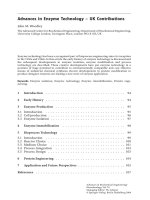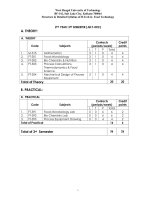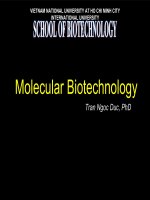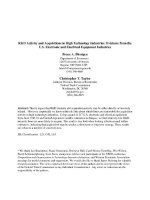Enzymes in food technology
Bạn đang xem bản rút gọn của tài liệu. Xem và tải ngay bản đầy đủ của tài liệu tại đây (14.76 MB, 270 trang )
Enzymes in Food
Technology
ROBERT J. WHITEHURST
BARRY A. LAW,
Editors
Sheffield Academic Press
CRC Press
Enzymes
in
Food Technology
Sheffield
Food Technology
Series Editors: B.A.
Law and
A.J. Taylor
A
series
which
presents
the
current
state
of the art of
chosen
sectors
of the
food
and
beverage
industry. Written
at
professional
and
reference level,
it
is
directed
at
food scientists
and
technologists, ingredients suppliers, pack-
aging technologists, quality assurance personnel, analytical chemists
and
microbiologists. Each volume
in the
series provides
an
accessible source
of
information
on the
science
and
technology
of a
particular
area.
Titles
in the
series:
Chemistry
and
Technology
of
Soft
Drinks
and
Fruit
Juices
Edited
by
P.R. Ashurst
Natural
Toxicants
in
Food
Edited
by
D.H. Watson
Technology
of
Bottled
Water
Edited
by
D.A.G. Senior
and
P.R. Ashurst
Environmental
Contaminants
in
Food
Edited
by
C.F.
Moffat
and
K.J.
Whittle
Handbook
of
Beverage
Packaging
Edited
by
G.A. Giles
Technology
of
Cheesemaking
Edited
by
B.A.
Law
Mechanisation
and
Automation
in
Dairy
Technology
Edited
by
A.Y. Tamime
and
B.A.
Law
Enzymes
in
Food
Technology
Edited
by
R.J. Whitehurst
and
B.A.
Law
Edited
by
ROBERT
J.
WHITEHURST
Kerry
SPP
Cambridge,
UK
and
BARRY
A. LAW
Food Science Australia
Victoria
Australia
Sheffield
Academic
Press
CRC
Press
Enzymes in Food Technology
First published
2002
Copyright
©
2002
Sheffield
Academic Press
Published
by
Sheffield
Academic
Press
Ltd
Mansion House,
19
Kingfield
Road
Sheffield
S1 1
9AS,
UK
ISBN
1–84127–223–X
Published
in the
U.S.A.
and
Canada
(only)
by
CRC
Press
LLC
2000
Corporate
Blvd., N.W.
Boca Raton,
FL
33431,
U.S.A.
Orders
from
the
U.S.A.
and
Canada
(only)
to CRC
Press
LLC
U.S.A.
and
Canada only:
ISBN
0-8493-9782-0
All
rights reserved.
No
part
of
this publication
may be
reproduced,
stored
in a
retrieval system
or
transmitted
in any
form
or by any
means, electronic, mechanical, photocopying
or
otherwise,
without
the
prior permission
of the
copyright owner.
This book contains information obtained
from
authentic
and
highly
regarded
sources.
Reprinted
material
is
quoted with permission,
and
sources
are
indicated. Reasonable efforts have been
made
to
publish reliable data
and
information,
but the
author
and the
publisher cannot assume
responsibility
for the
validity
of all
materials
or for the
consequences
of
their use.
Trademark
Notice:
Product
or
corporate names
may be
trademarks
or
registered trademarks,
and are
used
only
for
identification
and
explanation,
without
intent
to
infringe.
Printed
on
acid-free paper
in
Great Britain
by
Antony
Rowe Ltd., Chippenham, Wiltshire
British
Library
Cataloguing-in-Publication
Data:
A
catalogue record
for
this book
is
available
from
the
British Library
Library
of
Congress
Cataloging-in-Publication
Data:
A
catalog record
for
this book
is
available
from
the
Library
of
Congress
Preface
Enzymes
may be
described
as
'functional catalytic proteins'.
I do
hope,
how-
ever, that this volume will re-introduce them
as
useful
and
targeted work-
forces.
Like
the
more familiar human workforces, they have preferred work-
ing
conditions,
may be
trained (cultured)
to
carry
out
very
specific
tasks,
and
they
cannot function when their food (substrate) runs out.
The
purpose
of
this volume
is to
provide both
a
basic grounding,
for
those
not
experienced
in the use of
enzymes,
and a
state-of-the-art account
of
today's enzyme technology
as
applied
to
food
and
drink. Authors have been
selected
not
only
for
their practical, working knowledge
of
enzymes
but
also
for
their infectious enthusiasm
for the
subject.
Enzymes
are
introduced
first
according
to
their nomenclature
and
then
by
their
nature
and
mode
of
action. Chapters
go on to
describe
the
basic theory
and
practical applications
of
exogenous enzymes
in
food
and
drink tech-
nology,
and how
enzymes improve
raw
materials
and
influence
and
modify
the
biochemical
and
physical events that
we
describe
as
'food processing'.
Finally,
methods
of
culturing
and
manufacturing enzymes
in
commercial
quantities
are
described, together with
the
role that genetic engineering
has to
play
in
their
further
development.
Indigenous enzymes
in
food
raw
materials have long played
a
role
in
food
production. Today, however, enzymologists, working together with food
development technologists
and
with
a
view
to
market requirements, have
helped
and
improved upon nature
to
bring
us
varieties
of
food
and
drink that
were
unheard
of a
relatively short time ago. Examples
of
these
are
wines
which
mature earlier
and
have enhanced aroma
and
colour stability, 'naked'
but
undamaged citrus
fruit
(devoid
of its
pith
or
peel), bread that resists
staling,
and
enzyme-modified
cheeses.
Furthermore, production yields
and
purities
of
intermediate
raw
materials have been improved,
and
by-products,
previously
thought
of as
waste,
may now be
utilised.
My
thanks
to all the
contributors
to
this book
for
sharing their practical
approach
to the
subject.
I
hope that
the
reader
finds the
volume
as
rewarding
as I
found
its
preparation.
R. J.
Whitehurst
B.
A. Law
This page intentionally left blank
Contributors
Ms
Rose-Marie
Canal-Llauberes
Mrs
Cornelia
Drost-Lustenberger
Dr
Pierre
Fauquembergue
Mr
Mari
J. M. C. van
Gestel
Dr
Catherine
Grassin
Professor
Barry
A. Law
Mr
Per
Munk Nielsen
Mr
Hans
Sejr
Olsen
Mr
Maarten
van
Oort
Mr
Richie
Piggott
Ms
Joan
Qi Si
Mr
Diederik
J. M.
Schmedding
Mr
Reinhold
Urlaub
Novozymes, Cite Mondiale,
23
Parvis
des
Chartrons,
F-33074
Bordeaux Cedex,
France
Novozymes Switzerland
AG,
Neumatt,
4243 Dittingen, Switzerland
DSM
Food Specialties,
20 rue du
Ballon,
59041
Lille Cedex, France
PB 28,
Quest International,
PO Box 2,
1400
CA
Buss,
The
Netherlands
DSM
Food
Specialties,
20 rue du
Ballon,
59041 Lille Cedex, France
Food
Science Australia, Sneydes Road,
Private
Bag 16,
Werribee, Victoria
3030,
Australia
Novozymes A/S, Laurentsvej
55, DK-
2880
Bagsvaerd, Denmark
Novozymes A/S,
CLaurentsvej
55, DK-
2880
Bagsvaerd, Denmark
Novozymes, Biltseveste
12,
3432
AR
Nieuwegein,
The
Netherlands
Quest International, 5115 Sedge Blvd.,
Hoffman
Estates, Illinois 60192,
USA
Novozymes
SA, 79
Avenue Frangois
Arajo,
92017 Nanterre Cedex, France
PB 28,
Quest International,
PO Box 2,
1400
CA
Buss,
The
Netherlands
Rohm Enzyme Gmbh, Kirschenallee
45,
D-64293 Darmstadt, Germany
This page intentionally left blank
Contents
1
The
nature
of
enzymes
and
their action
in
foods
1
BARRY
A. LAW
1.1
Introduction
!
1.2
Enzymes
in
food
2
1.2.1
Enzyme nomenclature
2
1.2.2
Enzyme kinetics
3
1.2.3 Enzyme (in)stability
6
1.2.4 Composition
and
activity
of
commercial enzyme preparations
8
1.3
Sources
and
range
of
enzymes
for
food technology
9
1.4
Food
enzyme legislation
14
1.5
Modification
of
food enzyme activity
by
protein engineering
16
1.6
Summary
and
conclusions
18
References
18
Enzymes
for
bread, pasta
and
noodle products
19
JOAN
QI SI and
CORNELIA
DROST-LUSTENBERGER
2.1
Introduction
19
2.2
Bread
19
2.2.1
Fungal a/p/za-amylases
20
2.2.2 Amylases
to
extend shelf life
21
2.2.3 Xylanases/pentosanases/hemicellulases
28
2.2.4 Lipase
31
2.2.5 Oxidases
33
2.2.6
Synergistic
effects
of
enzymes
34
2.2.7 Enzymes
for
frozen dough
and
part-baked bead
39
2.3
Enzymes
for
Asian noodles
and
non-durum pasta
46
2.3.1 Reducing speckiness
46
2.3.2 Increasing brightness
and
colour
stability
46
2.3.3 Improving texture
48
2.3.4 Mechanisms
for the
effect
of
lipase
51
Acknowledgement
54
References
54
Enzymes
in
brewing
57
DIEDERIK
J. M.
SCHMEDDING
and
MARI
J. M. C.
van
GESTEL
3.1
Introduction
3.1.1
History
of
brewing
3.2 Raw
materials
CONTENTS
3.2.1 Malt
and
adjuncts
58
3.2.2
Hops
59
3.2.3 Yeast
59
3.2.4 Water
59
3.2.5 Exogenous enzymes
as
processing
aids
59
3.3 The
processes
of
malting
and
brewing
60
3.3.1
The
malting
process
61
3.3.2 Malt specification
61
3.3.3
The
brewing
process
62
3.4
Enzymes
in the
brewing
process
64
3.4.1 Enzymes
in
malting
64
3.4.2 Enzymes
in
mashing
66
3.4.3 Enzymes
in
adjunct
cooking
70
3.4.4 Enzymes
in
lautering/mash
filtration 70
3.4.5 Enzymes
in
fermentation
71
3.4.6 Enzymes
in
maturation
73
3.4.7 Chill proofing enzymes
73
3.4.8 Future developments
74
Acknowledgements
75
Further reading
75
Enzymes
in
wine production
76
MAARTEN
van
OORT
and
ROSE-MARIE
CANAL-LLAUBERES
4.1
Introduction
76
4.2
Legal
aspects
of the use of
enzymes
in
winemaking
76
4.2.1 Recommendations from international organisations
77
4.3
Enzymes
in
winemaking: history
and
definitions
77
4.4
Enzyme
properties
and
composition
78
4.5
Applications
of
enzymes
79
4.5.1 Enzymes
for
pressing
and
maceration
80
4.6
Enzyme applications
for
white
and
pink wine grape varieties
81
4.7
Enzyme applications
for red
wine
grape
varieties
83
4.8
Enzyme
applications
for
must
and
press
wines:
clarification enzymes
83
4.9
Enzyme applications
for
young wines: maturation
and filtration
enzymes
84
4.10 Enzyme preparations
for
aroma liberation
85
4.11
Enzymes
for
colour extraction
87
4.12
Other enzymes used
in
winemaking
87
4.12.1
Urease
87
4.12.2
Lysozyme
88
4.13
New
developments
88
4.13.1
Cork
cleaning
88
4.13.2 Colour stabilisation
88
4.13.3 Health issues
89
4.14 Conclusions
89
References
89
CONTENTS
XI
Enzymes
in the
manufacture
of
dairy products
90
BARRY
A. LAW
Introduction
90
Milk-clotting
enzymes
90
5.2.1
The
nature
and
identity
of
rennets
and
coagulants
91
5.2.2 Main
characteristics
of
rennets
and
coagulants from different sources
92
5.2.3 Production
of
rennets
and
coagulants
95
5.2.4 Formulation
and
standardisation
of
rennets
and
coagulants
96
5.3
Lactoperoxidase
96
5.4
Cheese
ripening enzymes
97
5.4.
i
Types
of
enzymes available commercially
97
5.4.2 Enzyme addition technology
99
5.4.3 Enzyme-modified cheese (EMC) technology
101
5.5
Lysozyme
103
5.6
Transglutaminase
104
5.7
Lipase
104
5.7.1
Lipolysed milk
fat
(LMF)
104
5.7.2
Lipase-catalysed
intra-
and
intermolecular modification
of
milk
fat 105
5.8
Lactase
105
5.8.1
Commercial dairy products
of
lactase technology
107
References
107
Enzymic modification
of
food protein
109
PER
MUNK
NIELSEN
and
HANS
SEJR
OLSEN
6.1
Introduction
109
6.2
Industrial
proteases
109
6.3
Protein hydrolysis
in
enzyme applications
110
6.3.1 Control
of
hydrolysis reaction
11 1
6.3.2 Calculation
of the
degree
of
hydrolysis
of
proteins using
the
pH-stat technique
1 12
6.3.3 Calculation
of the
degree
of
hydrolysis
of
proteins using
the
osmometry technique
114
6.3.4 Some kinetic aspects
of
protein hydrolysis
114
6.3.5
The
effect
of
proteolysis
116
6.4 The
bitterness problem
1 17
6.4.1
Other
off-flavour
problems related
to
bitterness
118
6.5
Protein hydrolysis
for
food processing
119
6.5.1
Inactivation
of
enzyme activity
and
downstream processing
120
6.6
Functional protein hydrolysates
122
6.7 Low
allergenic
peptides
for
baby food formulae
124
6.8
Meat extracts
! 25
6.9
Bone cleaning
127
6.9.1
Hydrolysis
of
meat protein
in
relation
to
bone cleaning
127
6.10 Enzymatic tenderisation
of
meat
129
6.11
Modification
of
wheat gluten
130
6.12
Use of
membranes
in
protein hydrolysis
processes
131
6.12.1
Functional protein hydrolysates
131
6.12.2
Low
molecular weight hydrolysates
132
6.12.3
The
membrane reactor
133
xii
CONTENTS
6.13
Flavour enhancers
134
6.13.1 Production
of
flavour enhancers
134
6.13.2
Enzymatically hydrolysed vegetable proteins
(e-HVP)
135
6.13.3
Hydrolysed animal proteins (e-HVP)
135
6.14 Yeast extracts
136
6.15 Fish
processes
137
6.16 Protein cross-linking
in
food processing
138
6.16.1
Applications
of
transglutaminase
139
References
140
7
Enzymes
in
fruit
and
vegetable juice extraction
144
REINHOLD
URLAUB
7.1
Introduction
144
7.2 The
legal situation
145
7.3
Definitions
and
characteristics
146
7.4
Pectins
147
7.4.1
Smooth-region pectinases
148
7.4.2 Hairy-region pectinases
149
7.5
Cellulose
and
hemicellulose
150
7.6
Starch
151
7.7
Protein
153
7.8
Application
of
technical enzyme products
154
7.9
Pome
fruit
processing
155
7.9.1 Enzymatic treatment
of the
mash
157
7.9.2 Pomace extraction
158
7.9.3 Maceration
159
7.9.4 Pomace maceration
160
7.9.5 Juice treatment
161
7.9.6 Traditional clarification
and filtration 165
7.9.7
Ultrafiltration
of
apple juice
166
7.9.8 Cloudy apple juice
or
apple juice concentrate
167
7.10 Grapes
168
7.10.1 Processing
of
Concord grapes
168
7.10.2
Manufacturing
white grape juice
and
grape juice concentrate
169
7.11
Berries
170
7.12
Stone
fruit
172
7.13 Citrus
fruit
172
7.13.1
WESOS
173
7.13.2 Citrus juice concentrates
175
7.13.3 Clear
and
semi-cloudy citrus concentrates
176
7.13.4
Extraction
of
citrus
oil 177
7.13.5
Cloudifier
178
7.14
Tropical
fruit
179
7.15
Vegetables
181
7.16 Membrane cleaning
182
References
182
CONTENTS
xiii
8
Enzymes
in
fruit
processing
184
CATHERINE
GRASSIN
and
PIERRE
FAUQUEMBERGUE
8.1
Citrus peeling
184
8.2
Citrus peel processing
186
8.3
Fruit
firming 187
8.3.1
Strawberries
194
8.3.2 Tomato
196
References
199
9
Enzymes
in
starch modification
200
HANS
SEJR
OLSEN
9.1
Introduction
200
9.2
Processing
and
enzymology
201
9.2.1
Starch liquefaction
201
9.2.2
tf/pte-Amylases 204
9.2.3 Saccharification
of
liquefied starch
210
9.2.4 Tailor-made glucose syrups
210
9.2.5
Use of
syrups
211
9.2.6 Production
of
maltose syrups
213
9.2.7
DX, DE and
reducing value
213
9.2.8 High conversion syrup
214
9.2.9 Production
of
high
dextrose
syrups
215
9.2.
i 0
Amyloglucosidase/pullulanus combination
in the
production
of
high
dextrose syrup
216
9.2.11
Continuous saccharification
217
9.2.12 Continuous saccharification
in a
membrane reactor
218
9.3
Enzymes
as
processing aids
in the
purification
of
saccharified wheat starch
218
9.4
Glucose isomerisation
219
9.4.1
The
isomerisation reaction
219
9.4.2 Isomerisation conditions
220
9.4.3 Isomerisation temperature
220
9.4.4 Isomerisation
pH 220
9.4.5 Isomerisation glucose (dextrose-DX)
and
fructose concentration
221
9.4.6
The
immobilised enzyme system
221
9.4.7 Process
lay-out
222
9.4.8 Enzyme decay
224
9.4.9 Controlling isomerisation costs
224
9.5 Use of
high-fructose corn syrups (MFCS)
225
9.6
Cyclodextrins
226
9.7 The
future
227
9.8
Conclusion
227
References
228
10
Commercial enzyme production
and
genetic modification
of
source
organisms
229
RICHIE
PIGGOTT
10.1
Brief
history
229
10.2
Sources
of
commercial enzymes
229
xiv
CONTENTS
10.2.1
Animal-derived
enzymes
230
10.2.2 Plant-derived enzymes
230
10.3 Microbial enzyme fermentation
232
10.4 Preservation
of
industrial microorganisms
233
10.4.1 Freezing
234
10.4.2 Freeze-drying
234
10.4.3
Subculturing
234
10.5 Inoculum development
234
10.6 Submerged fermentation
235
10.7 Separation
of
broth
236
10.7.1 Filtration with
filter aid 236
10.7.2 Microfiltration
237
10.7.3 Centrifugation
237
10.8 Concentration
237
10.9 Drying
238
10.10 Enzyme formulation
239
10.10.1
Powder blending
239
10.10.2 Liquid blending
240
10.11
Surface culture
(Koji)
fermentation
240
10.12
Intracellular enzyme production
241
10.13
Genetics
of
producer
organisms
242
Acknowledgements
244
References
244
Index
245
1
The
nature
of
enzymes
and
their
action
in
foods
Barry
A. Law
1.1
Introduction
Enzymes
are
proteins that
are
produced
by all
living organisms. They speed
up
chemical reactions selectively
as
part
of
essential
life
processes such
as
digestion, respiration, metabolism
and
tissue maintenance.
In
other words, they
are
highly specific
biological
catalysts.
The
enzymes work under more
or
less
mild
conditions (they have
to, in
order
to
operate
in
living
cells
and
life-
sustaining
environments), making them ideal catalysts
to use in
food technology,
in
which
the
manufacturer wants
to
modify
food
raw
materials selectively
without
destroying essential nutrients.
The
historical uses
of
enzymes
to
make
beer, wine,
cheese
and
bread
are
elegant examples
of the
industrial exploitation
of
the
power
and
selectivity
of
enzymes. Early food enzyme technologists were
clever craftsmen,
but
they
did not
realise that this
is
what they were doing,
and
that
they could have
adopted
such
a
splendid
job
title.
To
understand modern food enzyme technology,
it is
important
to
realise
that
these early enzymatic processes were
not
only fermentations,
but
also
complex
and
coordinated enzyme-mediated
processes.
The
enzymes were then,
and
remain, essential
for the
provision
of
fermentation substrates (beer
and
bread),
the
development
of flavour and
aroma (wine)
or the
creation
of the
very
structure
of the
product (cheese).
The
following chapters
of
this volume
will
describe
and
discuss
how
enzymes
do all of
these things
in
these
and
other
foods.
The
picture will emerge
of a
technology that began
as a
craft
and
has
become
a
sophisticated high-technology, high value-added industrial
sector. Enzyme production
and
application
in the
food manufacturing industry
is
based
on a
profound understanding
of the
role
of
enzymes
in
traditional foods,
from
which technologists have improved
the
basic processes
to
supply bigger
markets
with
safer
and
higher
quality
products. This understanding, together
with
improvements
in
enzyme sourcing
and
production technology,
has
also
yielded novel enzyme
technologies
to
create
new
foods
and
food ingredients,
as
will
also
be
revealed
by the
authors. This opening discussion will introduce
the
reader
to the
basic properties
of
enzymes,
the
methods used
to
quantify
them
for
technological use, their non-ideal behaviour
in
food
systems,
and the
range
of
food technologies
in
which
they
are
used.
2
ENZYMES
IN
FOOD
TECHNOLOGY
1.2
Enzymes
in
food
1.2.1 Enzyme nomenclature
Any
particular enzyme only
catalyses
reactions
between
one
type
(or a
narrow
range)
of
chemical compound (its substrate). This defines
its
'specificity'
and
provides
the
basis
of its
classification
and
name. Often,
the
trivial name
of the
enzyme, derived from
the
truncated substrate name with 'ase' added,
identifies
the
substrate
or
substrate
range
better
for
food
technologists
than
does
its
system-
atic name
or its
International Union
of
Biochemistry Enzyme Commission (IUB
or EC)
number [1].
For
example,
the
trivial name
for
lipid-hydrolysing enzymes
is
lipase,
but the
official
name
and
number
is
triacylglycerol acylhydrolase
(IUB/EC
3.1.1.3).
The
latter
is
precisely descriptive
of
what such enzymes
do, and the
term/number
is
vital
for
unambiguous communication between
biochemists
and
product chemists.
As far as
food technologists
are
concerned
though, lipases
act on
lipids
and
break them down
to
their component
fatty
acids
and
glycerol.
This
is the
important information
to be
used
in
food product
and
process terms,
and the
trivial names
of all
food enzymes
will
be
used
throughout this chapter. Thus, proteinases (usually shortened
to
protease)
chop
up
proteins
by
breaking
the
amide bonds that join their component amino acids
into
the
protein polypeptide chain. Carbohydrates would logically
be
broken
down
by
carbohydrases, though this
is not a
commonly used term, largely
because
carbohydrate building blocks
are
very diverse,
as are the
polymeric
structures
formed
from
them (the starches, cellulose, pectins). This diversity
will
become
clearer
to the
reader
as
this volume unfolds.
For
now,
suffice
it
to say
that more
useful
general terms
for
members
of
this class
of
enzyme
are
derived from individual
substrates.
Thus
lactase
breaks down
lactose,
maltase
breaks down maltose, pectinase breaks down pectin
and
cellulase breaks down
cellulose. There
is no
'starchase'
because
there
are too
many structural isomers
of
starch
on
which
to
base
the
obvious
trivial
name
for
starch degrading enzymes.
The
most ubiquitous
'starchase'
is
called alpha-amylase
because
it
chops
up the
amylose component
of
starch
at the
most common glucose-to-glucose bond
in
the
amylose polymer
(alpha-l–4).
Although
the
majority
of
enzymes (over 90%) used currently
in
commercial
scale food technology
are
hydrolytic substrate degraders like those mentioned
above, some enzymes used
to
improve
and
modify
food materials catalyse syn-
thetic
reactions
and
substrate interconversions. Most
are
quite easy
to
identify
with
their biochemical
function
because their names describe
the
main substrate
and
the
reaction;
for
example, glucose oxidase oxidises glucose
to
gluconic
acid, using
up
oxygen. However, this name does
not
tell
us
much about
the
technological
functions
it
performs, namely reducing glucose content
of egg
whites
to
reduce Maillard browning,
and
scavenging oxygen
in
packaging
technology. There
is
nothing
to be
done about
this,
other
than
for the
food
technologist
to be
aware
of the
technological
significance
of
glucose oxidation
ENZYMES
AND
THEIR ACTION
IN
FOODS
3
by
a
nice gentle enzyme. Similarly,
the
names glucose isomerase
or
lipoxygenase
tell
all
about
the
biochemistry involved,
but we
just have
to
remember
the
technology.
The
isomer
of
glucose produced
by
glucose
(strictly,
'xylose')
isomerase
is
fructose which, mole
for
mole,
is
sweeter than glucose
so the
enzyme
is
used
to
make
the
sweetener, high fructose corn syrup (section 1.3).
The
reactions catalysed
by
lipoxygenases used
in
bread improvement
are
quite
complex
[2] and not
altogether understood
by
research biochemists. Fortunately,
food
technologists understand empirically that
the
enzyme catalyses reactions
between lipids
in flour and
oxygen. Directly
and
indirectly these reactions
bleach
the flour and
make nice white bread,
and
also
modify
wheat proteins
so
that
they
help
in
forming good crumb structure
and
high loaf volumes
(chapter
2).
Some enzymes
are
easier
to
identify with their food applications than others,
but
many
of
these connections between nomenclature
and
technological
function
will
become
familiar
to the
reader throughout this
volume.
1.2.2 Enzyme kinetics
The
underlying mechanisms
of
enzyme action
and the
interactions
of
enzymes
with
their physical
and
chemical environment
can be
described mathematically
with
reasonable precision. However, most
of the
equations, constants
and
ground
rules (enzyme kinetics) have been worked
out for
idealised
situations
in
which
single
enzymes
act on
simple, single substrates under predictable conditions
found
within living cells.
The
reader
who
wants
to
understand these parameters
in
mathematical terms
can find an
excellent summary
and
reference list
by
Fullbrook
[3] in
'Industrial Enzymology' [4].
In the
same work, Fullbrook
[5]
also goes
on to
explain some
of the
pitfalls
of
applying
'classical'
enzyme
kinetics
to
non-ideal industrial processes.
Food technologists
not
only need
to
know which enzymes degrade, synthesise
or
interconvert which food material substrates,
but
also need
to
have
a
means
of
working
out how
much
of the
chosen enzyme
to use
under
any
particular
conditions
to
achieve
an
economical rate
and
efficiency
of
material conversion.
Qualitative
and
quantitative enzyme kinetics show
us
that enzymes behave
quite predictably
in
simple ideal systems such
as
those used
to
classify
and
characterise enzyme preparations
in
research
and QA
laboratories. They work
at
peak rates
at
particular
pH
values, temperatures
and
substrate concentrations
according
to
well-established
rules (figure 1.1).
At
fixed
substrate concentrations, enzymic reaction rates depend
on
enzyme
concentration
up to a
maximum, dependent
on the
turnover
efficiency
of the
particular
enzyme preparation.
The
'activity curves'
of the
type shown diagra-
matically
in figure 1.1 are
used
to
derive
the
numerical values
of
these param-
eters,
and
they
are
vital basic inputs into deciding which enzyme preparation(s)
should
be
used
in
which food modification process [3].
ENZYMES
IN
FOOD
TECHNOLOGY
3
5 7
pH
10
20 30 40
Temperature
(°C)
Substrate
concentration
Enzyme
concentration
Figure
1.1
Effect
of pH,
temperature, enzyme concentration
and
substrate concentration
on the
initial
rate
of
enzyme catalysed reactions
in
solution.
The
temperature
and pH
'profiles' derived
from
simple test conditions
are
usually
applicable
to
complex food environments because they
are
dependent
on
the
molecular
properties
of the
enzyme protein itself, rather than
on
those
of
the
substrate. Enzyme proteins
are
precisely folded polypeptide chains, held
together
by
relatively weak molecular forces.
The
folded structure determines
the
integrity
of the
catalytic site (the 'active
site',
figure
1.2)
within
the
enzyme,
and
this
is
easily disrupted
by
energy changes
in the
enzyme's environment
(temperature
being
a
prime example). This phenomenon
is
called 'denaturation'
Figure
1.2 The
three-dimensional folded polype-ptide chain
of an
enzyme protein,
illustrating
the
interactions between active site
functional
groups
(A and B)
and
substrate
(C)
which lower
the
energy needed
to
break
the
chemical bond
in the
substrate
and
thus
create
the
catalytic
activity
of the
enzyme.
6
ENZYMES
IN
FOOD
TECHNOLOGY
and it can be
reversible
or
irreversible dependent
on the
severity
of
structural
deformation
and
damage.
However, even small changes
in
intramolecular forces
in the
enzyme, such
as
those caused
by
small temperature changes,
or
pH-dependent charge differences
on
the
amino acids making
up the
primary polypeptide chain structures,
can
also
cause conformational changes
in the
structure that
fall
short
of
denatu-
ration.
Changes
of
this magnitude
are
manifested
in the
typical temperature
and
pH/activity curves
in figure 1.1 and
illustrate
how
precise
the
spatial
juxtaposition
of
active site
functional
groups
must
be to
reach
the
maximum
rate
of
catalysis. Thus,
as
reaction temperature
is
increased, classical chemical
kinetics dictate that
the
reaction
will
speed
up, but
beyond
a
certain temperature
(characteristic
of any
particular enzyme)
the
disruption
to the
enzyme protein
folded
structure reduces
its
catalytic
efficiency
and
activity
tails
off
again.
In
the
case
of pH, the
bell-shaped curve
is the
manifestation
of an
optimal
spatial structure
of the
enzyme protein which forms
at a
certain
pH,
when
the
relative ionisations
within
the
structure combine
to
orientate
the
active site
to
give
maximum substrate binding, bond modification,
and
release
of
product.
Either
side
of the
optimum
pH for
activity, changes
in
charge
and
hydrogen
bonding
efficiency
can
either distort
the
active site through changes
in the
three-
dimensional fold
of the
protein polypeptide chain
(figure
1.2),
or
reduce bond
dipoles
in
active site
functional
groups, reducing their capacity
to
lower
the
activation energy
for
conversion
of the
substrate(s).
The
understanding
of the
relationships between
the
amino acid sequences,
three-dimensional structures
and
catalytic
efficiencies
of
food enzymes
is now
sufficiently
comprehensive
to
allow molecular enzymologists
to
change
the
structures
of
food enzymes
to
improve their technological processing properties
such
as
heat resistance,
pH
optimum, resistance
to
catalytic poisons/inhibitors
and
even substrate preference. This
is
called 'protein engineering',
and is
reviewed
by
Goodenough
[6] and Law [7]
specifically
in
relation
to the
advanta-
geous
modification
of
enzymes
for
food ingredients synthesis. Other examples
appear later
in
section 1.5.
1.2.3 Enzyme (in)stability
Enzymes have
a finite
working
life,
or
half-life,
due to
inherent physical insta-
bility,
the
action
of
antagonists/inhibitors,
and
'poisoning'
by
contaminants
in
the
reaction
mixture.
In
foods
and
food
technology,
physical instability
can be
induced
by the pH and
temperature effects outlined above,
but
also
by
relatively
mild forces such
as
surface tension
in
foams
and
emulsions.
Most enzyme inhibitors would
not be
present
in
foods because they
are
gen-
erally poisonous (e.g. heavy metals
and
organometallic compounds),
but
many
enzyme antagonists
and
catalytic poisons
are
common
in
foods
and
food
raw
materials
(e.g. respectively, proteolytic enzymes
and
free
radicals
from
oxidised
ENZYMES
AND
THEIR ACTION
IN
FOODS
7
unsaturated fatty
acids).
Enzyme instability measured
for
purified
proteins
in
aqueous
buffers
can
give guidance
to
technologists
as to the
comparative stability
of
rival enzyme preparations under real processing conditions,
but
absolute
stability
can
only
be
determined
in
real food systems.
The first
decision
to
make
is
whether
the
process will benefit
from
stable
or
unstable enzymes.
Highly
stable enzymes
are
normally used
in
processes that take
a
long time
to
complete, such
as
malting
and
Koji fermentations,
or
where
the
enzyme
is
part
of a
diagnostic kit,
and has to
survive drying
and
long
storage
before use,
without
losing
its
standardised activity
at
manufacture.
On the
other hand, some
enzymes used
in
food manufacture
are
only required
to be
active
for a
short
time
to
scavenge oxygen,
to
precipitate milk proteins
or to
assist ripening
for
example,
and
their long-term
persistence
in the
food
is
either irrelevant,
or
even
detrimental. Specific examples
of
these applied scenarios
and the
criteria used
to
pick
the
right enzyme
for the job
will emerge
in the
following chapters. Some
of
the
special
factors that
influence
the
stability
and
half-life
of
enzymes
in
food
systems
and
food processing
are
listed
in
table 1.1.
There
are no
hard
and
fast rules
to
guide food technologists through this
largely
unexplored area
of
applied enzyme science because
the
research commu-
nity
has not
systematically studied
the
effects
of
phase structures
and
interfaces
in
food
on all of the
factors used
to
predict enzyme activity. However, based
on
table
1.1,
it may be
possible
to
avoid some
pitfalls,
or
even exploit some
Table
1.1
Special factors that
influence
the
stability
of
enzymes
in
food
Condition
Effect
on
stability Underlying cause
Phase concentration
of
enzyme
Presence
of
other
non-enzyme
proteins
Presence
of
other
enzyme
proteins
Stabilises
Stabilises
Destabilises
Presence
of
impurities
Destabilises
Increased
energy
per
unit
volume required
to
denature enzyme
Lowers proportion
of
denaturing energy
or
molecular
source
available
to
denature enzyme protein
If
accompanying
enzymes
or
proteinases,
they
may
degrade
the
added enzyme protein
Catalytic
poisoning
• of
lipases
by
free
radical-induced
chemical
damage
to the
enzyme
(especially
lipases)
• of any
enzyme
by
heavy metal atoms blocking
the
active
site
• of
metal requiring enzymes
by
chelating
agents
such
as
citric acid
or
polyphosphates
Phase interfaces Destabilises
Denaturation
by
surface tension forces
8
ENZYMES
IN
FOOD TECHNOLOGY
opportunities.
For
example,
a
supplier might recommend
an
enzyme addition
rate
of x
units
per
kilogram
of
food product,
based
on the
activity measured
against
the
substrate
in
solution.
The
food manufacturer calculates
the
cost
of
the
enzymatic conversion
based
on
this
figure,
adjusts
it to
compensate
for
differences
in pH and
temperature,
and
decides
how
much
the
enzymatic stage
will
cost.
This decision
process
is
based
on the
assumption that
the
enzyme
will
be
acting
in a
homogeneous environment similar
to
that under which
the
producer
assayed
it.
However, most foods
are
heterogeneous, consisting
of
discontinuous solid
composites
of
fat, protein, carbohydrates
and
water,
or
emulsions
and
foams with distinct phase boundaries. Such structures
in
food
tend
to
cause
any
added substance
to be
concentrated
by
affinity,
osmosis
or
differential
solubility into
one
particular component
or
phase
of the
food.
It is
therefore worth seeking from
the
supplier data
on the
solubility, hydrophobicity
and
resistance
to
surface tension denaturation
of the
enzyme,
so
that
the
costing
figures can be
adjusted
to '.v
units
per kg
bulk protein,
fat or
carbohydrate',
or
even 'per unit volume
of
water
in an
emulsion'. This might
produce
a
cost
figure
substantially
more
or
less than that based
on
assumptions
of
homogeneity.
1.2.4 Composition
and
activity
of
commercial enzyme preparations
Most commercial enzyme preparations contain
not
only
the
specific enzyme
whose activity
is
printed
on the
label,
but
also other enzymes that happen
to
be
produced
by the
same source material/organism [8].
The
enzyme user must
always
be
aware
of
this factor
in the
enzyme product specification
to
avoid
side effects
in
complex foods (e.g. starch breakdown
by an
enzyme preparation
bought
for its
proteinase function). Even
if the
application
is for an
isolated food
component such
as
whey protein,
a
heterogeneous enzyme preparation
can
pass
unexpected
and
unwanted enzyme activities
on to the
customer
who
buys
the
enzyme-modified
food ingredient unless steps
are
taken
to
inactivate
it
after
processing.
Thus, enzyme/substrate interrelationships
are
more complex
and
less pre-
dictable
in
food reaction environments because food materials
are not
pure
chemicals,
but
complex structures and/or poorly
defined
mixtures
of
potential
(possibly competing) substrates
and
inhibitors.
The
amount
of
enzyme required
to
convert
a
given amount
of
substrate
is
measured
in
'Enzyme Units'.
In
simple systems
the
original International
Union
of
Biochemistry Unit
(U) was the
'amount
of
enzyme that
will
catalyse
the
transformation
of one
micromole
of
substrate
per
minute under defined
conditions'.
The SI
unit
for
enzyme activity
is the
'katal'. defined
as the
'amount
of
enzyme that
will
cause
the
transformation
of one
millimole
of
substrate
per
second under specified conditions'.
Unfortunately
for
food technologists, even
a
substrate that
is
definable
in
food technology terms (e.g.
fungal
protein, vegetable protein extracts,
animal
ENZYMES
AND
THEIR ACTION
IN
FOODS
9
muscle,
com
starch, milk fat)
is
heterogeneous
as far as an
enzyme
is
concerned,
and
the
above unit definitions
are of
little
use to
them
in
process
design.
For
example,
corn starch consists
of
glucose polymers
of
infinitely-variable
molecu-
lar
weight with huge batch-to-batch differences, rendering impossible
any fixed
standard enzyme
dose
to
achieve
an
agreed specification
for a
hydrolysed starch
ingredient
product. Indeed,
it
would
be
impossible
to
define
an
enzyme unit
in
relation
to
such
a
substrate simply
because
a
millimole
or
micromole
of a
mixed
molecular
weight polymer cannot
be
defined. These factors mean that there
is
no
simple, consistent
way to
define
or
pre-determine
how
much enzyme
to add
to
how
much
raw
material
in
food processing.
In
practice, enzyme suppliers provide essential information
for
their cus-
tomers
by
defining units
in
terms
of the
technological
function
of the
enzyme.
This
not
only
allows
the
user
to
define
and
control
the
enzymatic process
on
an
industrial
scale,
but
sets
out the
basis
for
relating
the
cost
of the
enzyme
to
the
value
of the
product produced,
and
allows comparison
of the
productivity
of
enzymes
from
different
suppliers.
A
good example
of
such
a
pragmatic
and
direct
approach
to
quantifying enzymes
for
sale
and
dosing
is the use
of
'international milk clotting units' (IMCU)
for
quantifying
milk-coagulating
enzymes (chymosin, microbial rennets)
for
sale
and use in
cheesemaking.
The
enzymes
are all
acid proteinases that degrade caseins,
but
casein breakdown
itself
is not
usefully
related
to the
technological
function
of
destabilising casein
micelles
and
causing milk
to
clot.
The
IMCU
is a
measure
of the
ability
of
acid
proteinases, sold
as
cheese
milk coagulants,
to
clot
a
standard amount
of
milk
under standard conditions
in a
standard time relative
to an
international enzyme
reference
standard [8]. Other function-based
units
of
food processing enzyme
activity
are
based
on
such parameters
as
viscosity (reduction
or
increase),
conductivity
and
colour
binding.
1.3
Sources
and
range
of
enzymes
for
food
technology
The
traditional sources
of
food technology enzymes have been
the
tissues
of
plants
and
animals (table 1.2). Although these
are
still widely used
in
food
manufacture,
there
are
many
influences
driving food enzyme production
and
use
towards microbial alternatives, including genetically-modified derivatives
of
these organisms (GMOs).
There
are
many examples
of the use of
carbohydrate-degrading enzymes
in
food manufacture, particularly
in
baking, beer brewing
and
fruit
juice pro-
duction,
and
these will
be
covered
in
detail
in
chapters
2, 3 and 7 of
this
volume.
However, their economical production
from
efficient
microorganisms
in
industrial-scale fermenters means that
the
utilisation
of the
enzymes such
as
amylase
and
pectinase present
in the
traditional
raw
materials (wheat, barley,
citrus
fruits,
flour) is
confined
now to
their action
in
situ,
and
they
are not
widely
extracted
for
exogenous use.
10
ENZYMES
IN
FOOD
TECHNOLOGY
Table
1.2
Enzymes widely
sourced
from animals
and
plants used
in
food manufacturing technology
Enzyme
alpha-
Amylase
beta-Amylase
Papain
Bromelain
Ficin
Trypsin
Source
Cereal
seeds
e.g. wheat, barley
Sweet potato
Latex
of
unripe
papaya
fruit
Pineapple
juice
and
stem
Fig
fruit
latex
Bovine/porcine
pancreas
Action
in
food
Starch hydrolysis
to
oligosaccharides
Starch hydrolysis
to
maltose
Food
and
beverage
protein
hydrolysis
Muscle
and
connective
tissue
protein hydrolysis
As
bromelain
Food
protein hydrolysis
Food
applications
Breadmaking
brewing
(malting)
Production
of
high
malt
syrups
Meat
tenderisation
chill
haze prevention
in
beer
Meat tenderisation
As
bromelain
and
papain
but
not
widely
used
due to
cost
Production
of
hydrolysates
for
food
flavouring
(mostly
Chymosin
(rennet)
Pepsin
Lysozyme
Calf abomasum
Bovine
abomasum
Lipase/esterase
Gullet
of
goat
and
lamb: calf abomasum:
pig
pancreas
Lipoxygenase
Soy
bean
Hen
egg
white
Lactoperoxidase
Cheese
whey:
bovine colostrum
hydrolysis
As
chymosin
+
more general casein
hydrolysis
in
cheese
Triglyceride
(fat)
hvdrolvsis
Oxidation
of
unsaturated
fatty
acids
in flour
Hydrolysis
of
bacterial
cell
wall
polysaccharides
Oxidation
of
thiocyanate
ion
to
bactericidal
hypothiocyanate
replaced
now by
microbial
proteinases)
Coagulation
of
milk
in
cheesemaking
Usually
present
with
chymosin
as pan of
'rennet'
Flavour enhancement
in
cheese products:
fat
function
modification
by
interesterification
Bread dough improvement
Prevention
of
late blowing
defects
in
cheese
by
spore-forming bacteria
Cold sterilisation
of
milk
Certain
plant
and
animal
proteinases,
on the
other
hand, remain
in
widespread
use
through
their
well-established
effectiveness
in
some
fundamental
processes
in
cheese
production
and
meat
processing
(chapters
5 and 6). Of
particular
note
are
papain (and
the
related proteinases bromelain
and ficin) in
meat









